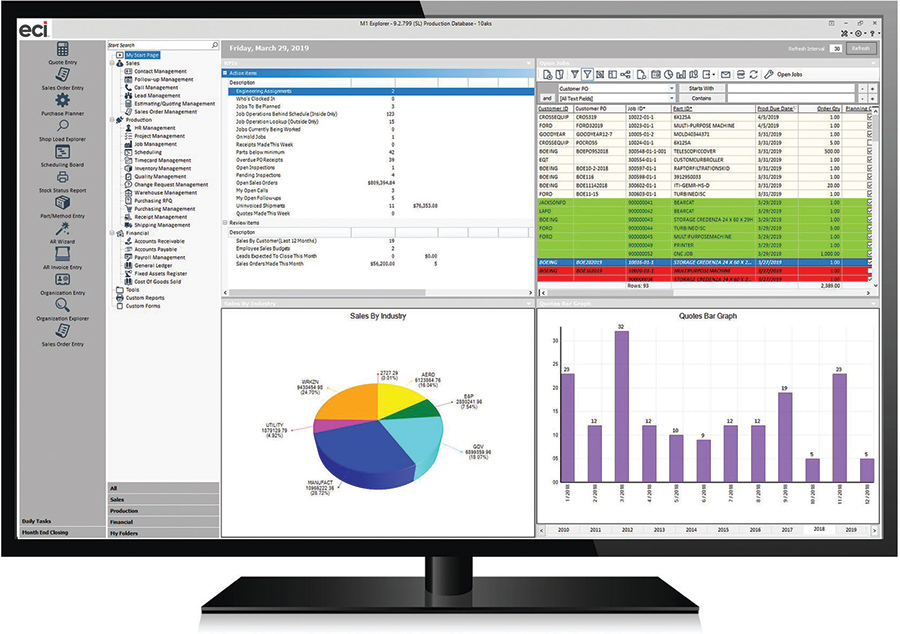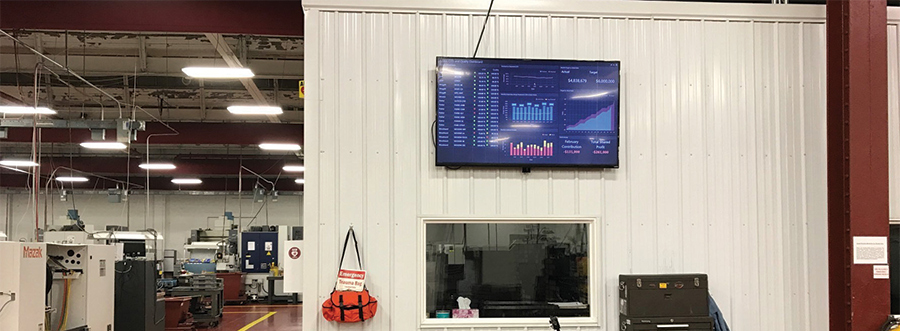software solutions / erp
veryone has heard about big data’s terminology and promise and can guess what it might mean to harness the intelligence that is lying around on the shop floor, at the sales desk, and even outside the company, among vendors and customers. It’s perhaps a fear that they won’t see an obvious ROI that keeps smaller and midsize metals suppliers and manufacturers from pulling the trigger on acquiring enterprise resource planning tools that would make their operations hum.
Matt Heerey, president of the manufacturing division of ECI Software Solutions, Fort Worth, Texas, has been working with small and midsize manufacturers for many years.
Often, he says, “metal fab shops come to us, and their only access to data is paper, routers, Quickbooks and an Excel spreadsheet. We help them to migrate from those systems to an ERP solution.” With this software tool, “we uncover and capture data from all aspects of an operation and create reports, which is common. But we now also put dashboards in offices and shop floors, giving everyone the ability to see what’s going on in real time and to make decisions accordingly. Many job shops didn’t have that ability historically.”
Today, ERP is helping metalformers and metals-consuming manufacturers to integrate their data. “You can pull bills of material and raw material components out of CAD and use it to populate programs, making it easier to deliver quotes,” Heerey says.
More companies are using automation, such as bar code scanning, and extracting data from machines to monitor productivity, obtain maintenance status, etc., and this trove of information is fed back into ERP, he continues.
“For metals companies,” says Logan Paquin, director of product management for ECI’s manufacturing division, “big data is sensible and useful. Our customers want to be proactive and have a deeper understanding of their data so they can answer. Now more than ever, organizations have access to the Internet of Things and realize how inexpensive it is to store and share information in the cloud.”
Possibly the most important point is “to make sure the data is accurate. You must have clean databases. In addition to providing ERP software and support, ECI works to get that data accurate so that the quality is there to make decisions,” he says.
ECI’s KnowledgeSync, for example, “is a force multiplier,” Heerey says, which is crucial because many users “don’t have the cash to hire extraneous employees.” This tool scans databases in ERP and other software programs and finds out when a value in a record changes, or when an order is placed, and automatically alerts the back office to conduct a credit check. It can trigger other types of notices in other systems, too.

ECI also has a cloud platform called Cognytics that takes in analytics and data visualization and pulls from all different inputs and makes it visible on computer monitors, tablets and smartphones. The information is comprehensible for individual users.
“In the past,” says Paquin, “companies would purchase equipment but sometimes struggle with trying to make sense out of the machinery due to time, cost and uncertainty. With Cognytics, we can find information and put it into presentable tables and have that in real time. It’s one way to leverage big data.”
 if they aren’t making money, they can drop a process and focus on areas that do make money.
if they aren’t making money, they can drop a process and focus on areas that do make money. 
“Our solution reads the data, the sales manager reads the data, the shop foreman reads the data and they make decisions to save money and increase productivity. It’s putting light to the dark,” Paquin says.
“You see who should be doing what. It’s on a tablet, and the info can be reviewed. Say you take scheduling and planning, and take more data about the machine performance and downtime versus uptime. You can use the alerts system to change what shop floor employees are doing to run more efficiently. That is on our roadmap to begin developing in 2020. It will take advantage of big data and give it to the customer,” he says.

To perform preventive maintenance, companies often schedule down time to work on all of their machines every three months, whether it is necessary or not.
“Manufacturers are putting sensors on machines that sense sounds and vibrations. A machine running in balance has a heat signature,” Heerey says. “If the parts wear, heat and vibration rise. You can even check the lubricity of greases and oils. We are considering how to incorporate that data into our ERP systems to help companies anticipate the changing characteristics, e.g., what part will go bad and when.
“When you are able to predict, you only fix what’s needed and in a timely fashion, minimizing accidents and costs. It’s coming from ERP and from IoT, making intelligence available and actionable,” he says.
By employing information like this, a company can reduce its equipment operating costs by anywhere from 10 to 40 percent and reduce downtime by up to 50 percent, says Heerey, all while increasing the life of the machine.
“Instead of replacing it every 10 years, you can make it last 15 or 20 years,” Heerey says. “This is becoming more prevalent, and the costs go down as more people adopt these technologies. It’s a standard adoption curve.”